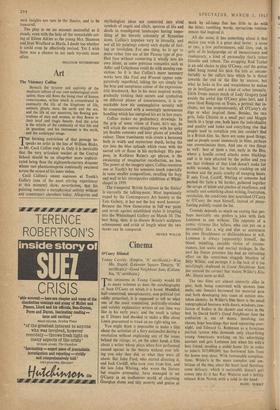Art
The Visionary Collins
Beneath the tyranny and captivity of the mediocre culture of our own technological civili- sation, there still flows the living river of human consciousness, within which is concentrated in continuity the life of the kingdoms of life, animals, plants, stars, the earth and the sea, and the life ot our ancestors, the flowing gen- erations of men and women, as they flower in their brief and tragic beauty. And the artist is the vehicle of the continuity of that life and its guardian, and his instrument is the myth, and the archetypal image.
THE burning conviction of that passage be- speaks an artist in the line of William Blake, as Mr. Cecil Collins truly is. Only it is inevitable that the very articulate teacher at the Central School should be an altogether more sophisti- cated being than the eighteenth-century dreamer whose vast phantasmagoria continually swarmed across the screen of his inner vision.
Cecil Collins's recent canvases at Tooth's Gallery (one of the most stirring experiences at this moment) show, nevertheless, that his painting remains a metaphysical activity without any counterpart elsewhere today. Allegories and mythological ideas are converted into vivid symbols of angels and sibyls, spectres of life and death in transfigured landscapes having some- thing of the hieratic solemnity of Byzantine icons. Collins's impulses vary in intensity, and not all his paintings convey such depths of feel- ing or revelation. For one thing, he is apt to make rather free use of the Picasso type of pro- filed face without converting it wholly into his own idiom, as some previous romantics such as Adler and Colquhoun could do with moving con- viction. So it is that Collins's more summary works here like Fool and Woman appear com- paratively superficial, taking the eye simply for the brio and sumptuous colour of the expression- istic brushwork. But in his most inspired works, gradually yielding their secrets and symbolism on different planes of consciousness, it is re- markable how his contemplative serenity will be communicated with a seemingly spontaneous handling which has energised his art in late years.
Collins makes no preliminary drawings. In the grip of some vision of Faust, let's say, he will attack the canvas straightway with his spiky yet flexible contours and later glazes of jewelled colour. These translucent veils create a harmony both in width and mysterious depth, luring the eye into the blue uplands which recur with the sacred orb or flame in his mythology. His pur- pose, in Kathleen Raine's apt phrase, is the awakening of imaginative recollection, no less. The power of the imagery apart, Collins reassures one at Tooth's by his sensuous touch especially in some smaller compositions, recalling the fiery end wall in his retrospective exhibition at White- chapel in 1959.
The trumpeted 'British Sculpture in the Sixties' is currently the talking-point. Most ingeniously staged by the Contemporary Art Society at the Tate Gallery, it has not the last word however. Because the New Generation in full war paint and revolt against established styles is irrupting into the Whitechapel Gallery on March 10. The best thing, then, is to discuss Britain's sculpture achievement and crisis at length when the two shows can be compared.
NEVILE WALLIS


































 Previous page
Previous page